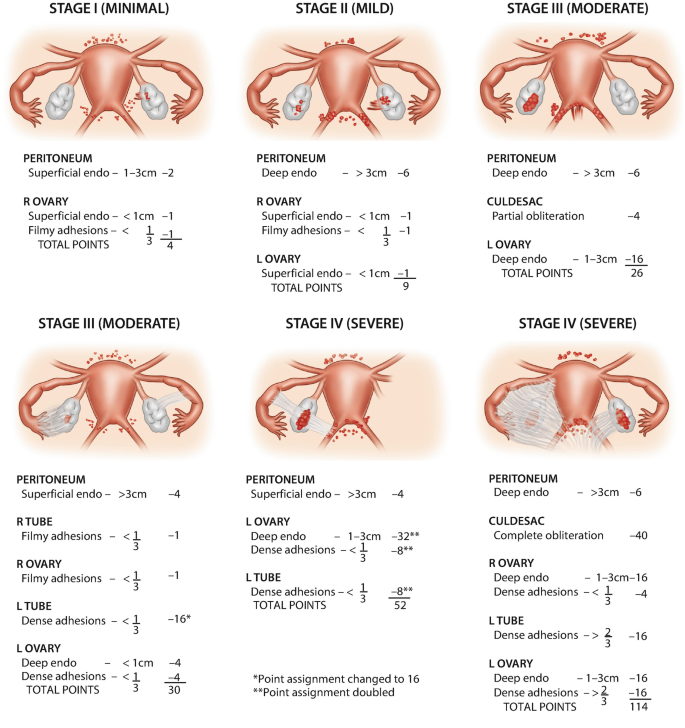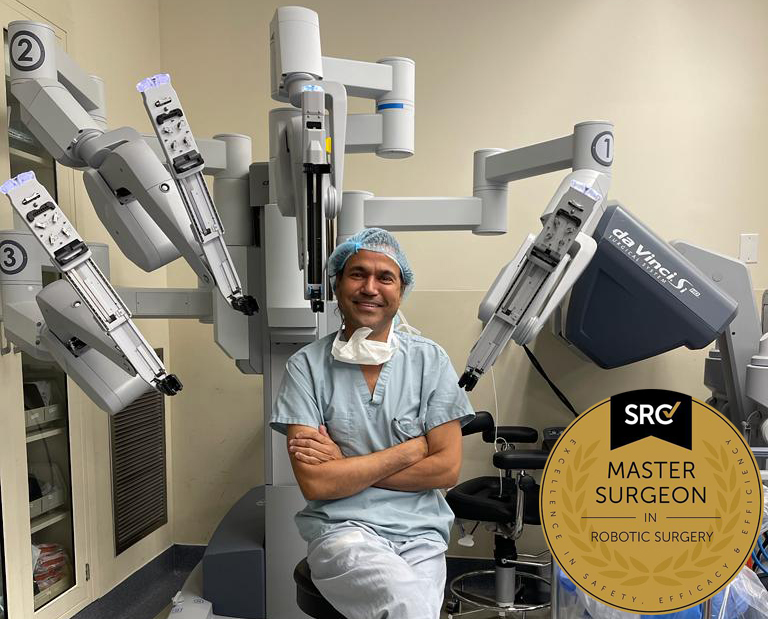Stages of Endometriosis
Endometriosis is categorized into four stages, namely: Stage I, which is minimal; Stage II, characterized as mild; Stage III, denoted as moderate; and Stage IV, indicating severe.
Endometriosis is a condition in which the tissue similar to the lining of the uterus (endometrium) grows outside the uterus, leading to various symptoms and potential complications.
The stages of endometriosis are typically classified according to the severity and extent of the disease, often referred to as the revised American Society for Reproductive Medicine (rASRM) staging system. This system categorizes endometriosis into four stages:
Stage I: Minimal
- There are superficial implants of endometriosis that may be a few small lesions or filmy adhesions.
- There is minimal or no scar tissue or adhesions affecting the pelvic organs.
Stage II: Mild
- There are mild lesions or superficial implants of endometriosis on the pelvic lining or organs.
- There may be some scar tissue or adhesions, but they are not extensive.
Stage III: Moderate
- There are multiple implants of endometriosis, some of which may be deep.
- There are more adhesions and scar tissue present, leading to organs potentially becoming stuck together.
- Endometriomas (cysts) may be present on the ovaries.
Stage IV: Severe

Stages of Endometriosis (Image source: Springer Nature Switzerland AG, 2022)
Descriptive Classifications of Endometriosis
In addition to the staging systems, endometriosis can also be described using descriptive classifications that provide more information about the characteristics and location of the lesions. These descriptive classifications help in understanding the extent and specific features of endometriosis. Here are some common descriptive classifications:
- Superficial peritoneal endometriosis: This refers to the presence of endometriotic lesions on the peritoneum, which is the lining of the pelvic cavity. These lesions are typically shallow and superficial, and they may appear as small red or brown patches.
- Deep infiltrating endometriosis (DIE): This classification refers to the presence of endometriosis lesions that penetrate deeply into the surrounding tissues beyond the peritoneum. DIE can involve structures such as the uterus, ovaries, fallopian tubes, bowel, bladder, and other pelvic organs. The depth of infiltration and involvement of different organs can vary.
- Ovarian endometriomas: These are also known as chocolate cysts. They are cystic masses that form on the ovaries due to the accumulation of old blood from endometriosis lesions. Ovarian endometriomas can vary in size and may cause pain and discomfort.
- Adenomyosis: Although not strictly classified as endometriosis, adenomyosis is a condition where endometrial tissue grows into the muscular wall of the uterus. It can cause symptoms such as heavy and painful periods, and it is often associated with endometriosis.
- Extra-pelvic endometriosis: In some cases, endometriosis lesions can be found outside the pelvic region. They may occur in areas such as the abdominal wall, diaphragm, lungs, or other distant sites. This is referred to as extra-pelvic endometriosis.
It’s important to note that these descriptive classifications are used to complement the staging systems and provide a more detailed understanding of the characteristics and distribution of endometriosis.
- New York Gynecology Endometriosis
- Contact Info:
-
375 E. Main Street,
Suite 7, Bay Shore,
NY 11706 - (631) 533-9733
Pankaj Singhal, MD, MS, MHCM
Master Surgeon in Robotic Surgery
Dr. Pankaj Singhal, a globally recognized endometriosis surgeon, possesses over 25 years of expertise in laparoscopic excision surgery, enabling him to tackle even the most challenging endometriosis cases with confidence. Dr. Pankaj treats patients with diverse endometriosis-related conditions, ranging from ovarian endometriomas to severe deep infiltrating endometriosis that affects the bowels and other organs.
Dr. Pankaj prioritizes minimally invasive surgery and provides comprehensive personal care. Additionally, he is the owner and founder of New York Gynecology and Endometriosis (NYGE), and has dedicated his life to advocating for, respecting, and treating women suffering from this little-known disease. He is one of the few surgeons in the entire United States who have completed over 5,718 robot-assisted gynecologic surgeries.

We Accept Most Major Insurance Plans
Convenient Billing Options for Comprehensive Coverage.
Surgeries are typically covered by health insurance. However, the extent of coverage can vary depending on the specific insurance plan and policy. Some insurance plans may cover a broad range of surgical procedures, including both elective and necessary surgeries, while others may have limitations or exclusions for certain procedures.
In some cases, certain insurance plans or programs may fully cover the cost of surgery, leaving the patient with no financial responsibility.
Request an Appointment with
New York Gynecology Endometriosis
"*" indicates required fields
